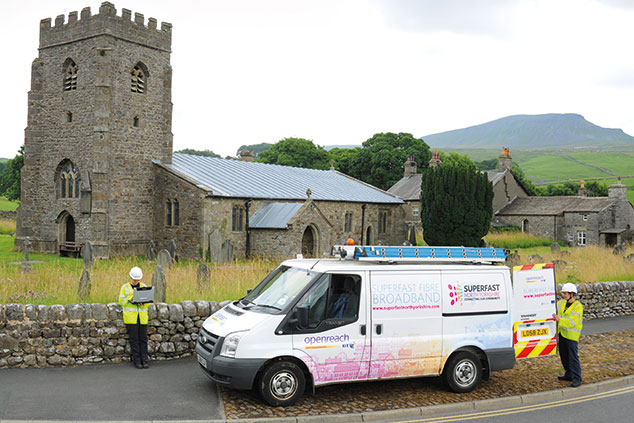
What’s happened?
The Labour Party has pledged, if elected, to ensure all UK households and businesses have “free” full-fibre ultrafast broadband connections by 2030. To achieve this, a Labour government would nationalise Openreach, the network arm of BT, to create a new state-owned enterprise called British Broadband, which would build and run the new network.
According to Labour’s proposals, the cost of building the network would be £20bn, and the annual cost of running it would be £230m, to be paid for via a new tax on multinational companies based on UK sales (rather than profits). “A new public service delivering the fastest broadband free to everyone is at the heart of Labour’s plans to transform the future of our economy and society”, explained leader Jeremy Corbyn.
Do the costings look realistic?
They’re on the low side. Last year, the National Infrastructure Commission put the cost of such a network at £33bn. BT’s CEO Philip Jansen put the initial cost at between £30bn and £40bn, and points out that giving away the product for free would wipe out annual revenues of £5bn, boosting the true cost to the region of £80bn-£100bn over the first eight years.
And Nick Delfas, an analyst with Redburn, says that Labour seems to be dramatically underpricing the ongoing cost. “The maintenance cost of a national fibre network will be at least £1bn-£2bn, not £230m as claimed,” he reckons. “And the public sector will be exposed to build cost overruns, as with HS2 and Crossrail. Finally, TalkTalk and Virgin Media would go bankrupt.”
What exactly is full-fibre broadband?
Whereas the UK’s old landline telephone infrastructure uses copper cables, fibre-optic cables (made from glass or plastic) use pulses of light to transmit data, allowing much faster transmission speeds.
Currently, the UK authorities define “superfast” broadband as a connection with speeds greater than 30 megabits per second (Mbps, the standard measure of internet connection speed). This level (and up to 66Mbps) can be achieved using a FTTC (“fibre to the cabinet”), where copper wires are still used for the last stretch from the cabinet to the house.
But to get an “ultrafast” connection of more than 100 Mbps, you need a full-fibre, or FTTP (“fibre to the premises”) connection. That’s one that uses a fibre-optic cable to connect from the telephone exchange to households without any copper at all. With this system, users get faster average speeds of 1,000 Mbps (one gigabit) and low latency (the delay experienced in executing a request).
How does the UK compare globally?
Very poorly. According to Ofcom, only 8% of UK homes and businesses have access to full-fibre, or around 2.5 million properties. That makes us 25th out of 28 EU countries (according to European Commission figures from 2018). Only Belgium, Cyprus and Greece have lower penetration, and the only other country that has less than 10% full-fibre coverage is Germany. That put us a long way behind countries such as Latvia (just under 90%) and Spain, Portugal and Sweden (70% or higher).
What about further afield?
The picture is just as unimpressive. When it comes to the basics, Britain does OK. Ofcom’s most recent global comparison put us fourth out of 19 countries surveyed for speeds of 10 Mbps, and fifth for speeds of at least 30 Mbps. But for speeds of over 300 Mbps, we were near the bottom (15th). And for full-fibre, we were next to bottom, with only Nigeria ranked lower.
Similarly, the OECD’s most recent survey put us 35th out of 37 countries ranked by the proportion of fibre in the overall fixed broadband infrastructure. Global leaders include Japan, which has successfully boosted full-fibre coverage from about 23% in 2009 to more than 95% today, and South Korea, which is more than 95% full-fibre. In the US, one-gigabit services are available in 80% of the country.
So Labour’s plan is just what’s needed?
Hardly. MoneyWeek readers will need few reminders about the propensity of state-owned utilities to turn into bloated bureaucracies, and the disincentives to investment in the sector that the Labour proposal will bring. “Nor have the customer-service demands involved in running high-speed data networks ever been a strength of government monopolies,” as the FT points out.
But if we are to emulate high-achievers such as Japan and South Korea, the solution is likely to involve some input from the state. In Japan, the government provided strategic direction and incentives to stimulate competition. And in South Korea, too, the 95% full-fibre mark has been achieved via an “approach based on market principles alongside state-led investment”, says Richard Partington in The Guardian.
If the Conservatives win the coming election, they have promised to invest £5bn in ensuring all UK households enjoy “gigabit speeds” by 2025. The detail of how that money will be spent, and how they will achieve that target, is very vague.
Might fixed broadband soon be obsolete?
It’s possible. Some technology pundits speculate that 5G mobile communications, and whatever the sixth and subsequent generations might bring, could at least partly replace the need for fixed-line internet connections.
But as things stand, it’s best to see full-fibre broadband and 5G mobile as complementary technologies, not competing ones, says Andrew Ferguson of thinkbroadband.com. 5G networks can operate on several different frequencies, including higher frequencies that require many more transmitters, closer to the homes and offices that need internet access. And these “nano-masts” are typically connected to the internet backbone by fibre. “Investing in fibre improves both fixed-line services and helps to support connecting the many new nano-masts needed for 5G at its highest speeds,” says Ferguson.
Labour’s audacious proposal may not be the answer, but it has helped focus minds on the question of the UK’s broadband deficit.